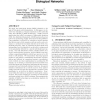61 search results - page 8 / 13 » The Factor Structure of the System Usability Scale |
JCM
2008
13 years 7 months ago
2008
In this paper, we present a new simulation platform for complex, radio standard spanning mobile Ad Hoc networks. SimANet - Simulation Platform for Ambient Networks - allows the coe...
RECSYS
2010
ACM
13 years 7 months ago
2010
ACM
Recommendation systems suggest items based on user preferences. Collaborative filtering is a popular approach in which recommending is based on the rating history of the system. O...
ATAL
2003
Springer
14 years 26 days ago
2003
Springer
We apply the multi-agent system (MAS) platform to the task of biological network simulation. In this paper, we describe the simulation of signal transduction (ST) networks using t...
BMCBI
2008
13 years 7 months ago
2008
Background: Quasi-steady state approximation (QSSA) based on time-scale analysis is known to be an effective method for simplifying metabolic reaction system, but the conventional...
MOBISYS
2010
ACM
13 years 10 months ago
2010
ACM
We present Darwin, an enabling technology for mobile phone sensing that combines collaborative sensing and classification techniques to reason about human behavior and context on ...

